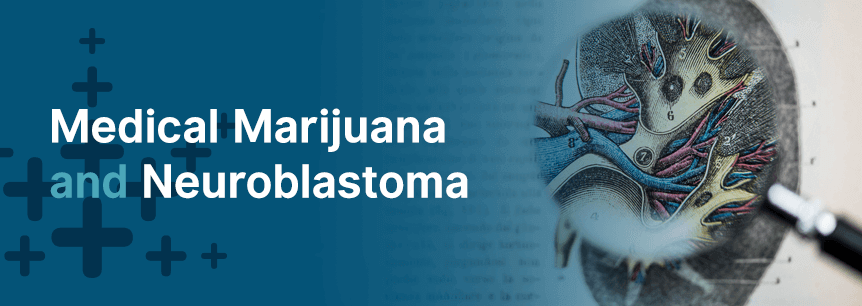
Neuroblastoma causes a whole range of symptoms including diarrhea and bone pain, which are symptoms medical cannabis can help treat. Neuroblastoma is one of the most common types of cancer in infants. Since it metastasizes or spreads, to other areas of the body, doctors consider it an aggressive tumor. Learn more about neuroblastoma, and how medical marijuana is becoming an alternative treatment for it.
Neuroblastoma is a form of cancer that develops in the nerve tissue. It generally starts in the adrenal glands, but it can also start in the chest, neck or spinal cord. It usually affects children and hardly ever occurs in adults.
For many years, doctors have diagnosed, on average, approximately 800 new neuroblastoma cases every year in the U.S. Physicians diagnose almost 90 percent of neuroblastoma cases in children around age 5. The average age kids receive a diagnosis is 1 to 2 years old. In some cases, it starts before the birth of a child.
According to the American Cancer Society, in around two-thirds of cases, it’s already spread to other areas of the body, like the lymph nodes, at the time of diagnosis.
While parents may pass a form of neuroblastoma called the familial type to a child, 98 percent of the cases are not inherited.
Generally, cancer starts with a genetic mutation that allows healthy, normal cells to continue to proliferate. Unlike regular cells, they fail to respond to the signals to stop, eventually multiplying out of control. These built-up abnormal cells form a tumor or mass.
Neuroblastoma starts in immature nerve cells called neuroblasts that the fetus creates during its development process. As the fetus begins maturing, the neuroblasts gradually turn into nerve fibers and cells and the cells making up the adrenal glands.
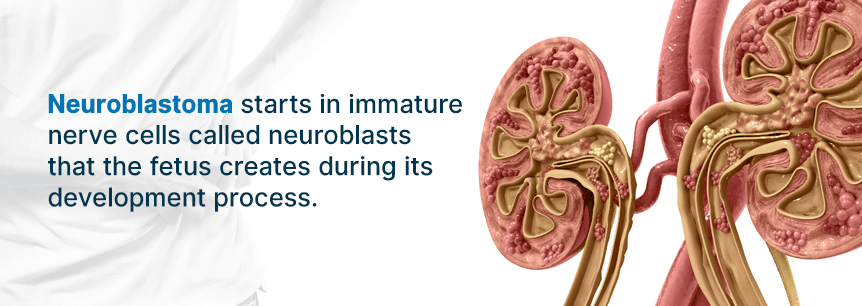
Most neuroblasts will have matured by birth, although physicians discover a few immature neuroblasts in infants. Most of the time, the neuroblasts mature or go away, while others form into a tumor.
The causes of the initial genetic mutation leading to neuroblastoma remain unclear.
Children with neuroblastoma might develop general symptoms early on, such as fever, irritability, pain, weight loss, tiredness and loss of appetite. Because these symptoms can resemble other conditions, parents may suspect the signs could be neuroblastoma.
More specific symptoms depend on where the tumor sits and where it’s spread. For instance, neuroblastoma may involve:
Additionally, neuroblastoma may release hormones that could cause other symptoms like rapid heartbeat, high blood pressure, sweating and flushing of the skin. In a few cases, children with neuroblastoma have developed opsoclonus-myoclonus syndrome, which causes jerky muscle motions and rapid eye movements.
Complications of neuroblastoma might include:
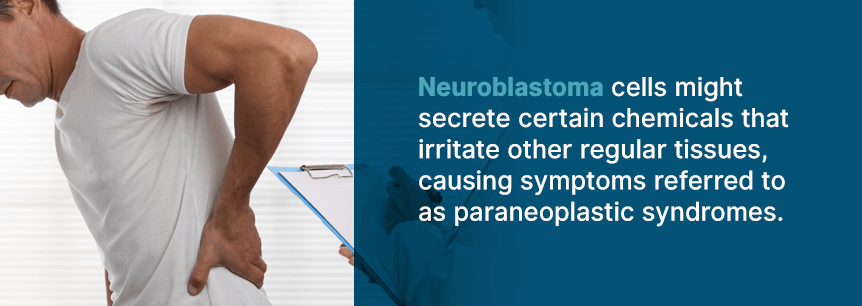
Once the doctor diagnoses neuroblastoma and before the medical oncology team derives the treatment protocol for neuroblastoma, they’ll order testing to figure out the extent of cancer and if it has spread to other organs. These test may include imaging studies, such as X-rays, CT, MIBG, MRI and bone scans, and urine and blood tests, to aid in staging cancer. In some cases, the oncologist might recommend a biopsy and/or bone marrow aspiration. Knowing the stage of cancer helps the medical oncology team decide the appropriate treatment.
Roman numerals identify neuroblastoma stages beginning with 0 to ending at IV. The lowest stage indicates cancer remains limited to one specific area. By stage IV, cancer has advanced and spread to other body areas.
The doctor chooses the treatment plan based on factors affecting the prognosis. Factors are the stage of cancer, your child’s age, the types of cells involved in cancer and if there are abnormalities in the genes and chromosomes.
The doctor will use this information to put cancer in a category of low, intermediate or high risk. The treatment or combination of treatments for the neuroblastoma will depend on the risk category.
Neuroblastoma treatments might include:
Surgeons use surgical tools like scalpels to remove the cancer cells. For the “low-risk” neuroblastoma, the surgeon may only need to remove the tumor. The ability to remove the tumor completely will depend on its size and location. Tumors attached to neighboring vital organs like the spinal cord or lungs might be too risky to remove.
In intermediate and high-risk neuroblastoma, surgeons might try and eliminate as much of the tumor as they can. It might require other treatments like radiation and chemotherapy to kill the remaining cancer cells.
Chemotherapy uses chemicals for destroying the cancer cells. It targets quickly growing body cells, including cancer cells. Unfortunately, it also damages rapidly growing healthy cells like cells in the gastrointestinal system or hair follicles, which can cause side effects such as nausea, vomiting and hair loss.
Children with intermediate-risk neuroblastoma often receive a mixture of chemo drugs before surgery for improving their chances of having the whole tumor removed.
Those with high-risk neuroblastoma typically receive high doses of chemo drugs to shrink their tumor and kill any cancer cells that have spread to other areas of the body. Oncologists typically administer chemo to the patient before surgery and before a bone marrow transplant.
Radiation therapy involves using high-energy beams like X-rays to destroy cancer cells.
Kids with low- or intermediate-risk neuroblastoma might receive radiation therapy if the chemotherapy and surgery haven’t helped. Those with high-risk neuroblastoma might receive radiation therapy after surgery and chemo to keep cancer from recurring.
Radiation therapy mostly affects the targeted area, but it could damage some healthy cells. The side effects your child experience will depend on where the doctor directs the radiation and how much they receive.
Those with high-risk neuroblastoma might receive a transplant using bone marrow stem cells, which doctors also call an autologous stem cell transplant.
Before the transplant, your child will undergo a procedure to filter and collect stem cells from their blood, which remained stored for later use. Your child will then receive high doses of chemotherapy to kill any remaining cancer cells in their body. The doctor then injects the stem cells into their body, where they can begin forming new, healthy blood cells.
Immunotherapy uses medications that signal your child’s immune system to help attack the cancer cells. With high-risk neuroblastoma, your child might receive immunotherapy drugs through an injection to stimulate their immune system into killing the neuroblastoma cells. Nerve pain, infection, nausea and vomiting, allergic reactions and leaking of body fluids are some of the side effects of immunotherapy.
Physicians are studying a new type of radiation therapy that could help manage high-risk neuroblastoma. It uses a radioactive type of the chemical metaiodobenzylguanidine (MIBG). When injected into the bloodstream, it travels to the cancer cells and releases the radiation.
Physicians may combine this therapy with a bone marrow transplant or chemotherapy. After your child receives the radioactive MIBG injection, they’ll need to stay in a special room of the hospital until they urinate all the radiation from their body. MIBG therapy typically takes several days.
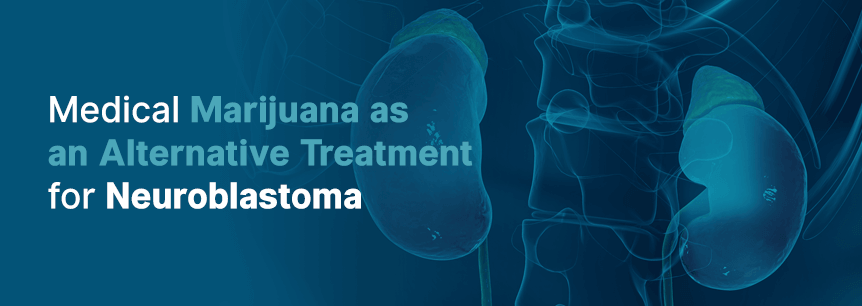
Research shows marijuana’s major cannabinoids like THC have anti-cancer effects, inhibiting the progression of cancer. In animal and culture models, cannabinoids have shown the capability of limiting or even killing the growth of cancerous cells.
Studies suggest the cannabinoid’s anti-cancer effects are related to how they interact with the cannabinoid receptors of the endocannabinoid system.
The cannabinoid’s anti-cancer properties have shown to apply to neuroblastoma cells. A study showed cannabinoids inhibited the cells’ viability and metabolism, thereby combating neuroblastoma.
Medical marijuana for neuroblastoma helps treat several symptoms of neuroblastoma, including:
Medical weed is beneficial for treating cancer-related symptoms and its treatments — like nausea from chemotherapy, according to studies. Studies have conclusively shown medical pot, including THC and other cannabinoids, works as an antiemetic, or anti-nausea, treatment. Sometimes, it works better than other prescription medicines for nausea.
Doctors sometimes use medical marijuana in combination with other antiemetics with great results. Research has suggested combining these antiemetics increased the medicine’s effects, which indicates patients can use cannabis alongside other antiemetics that require better results or as a stand-alone antiemetic.
Effective nausea strains are:
Marijuana for neuroblastoma has effectively lowered neuropathic pain that standard treatments weren’t able to manage.
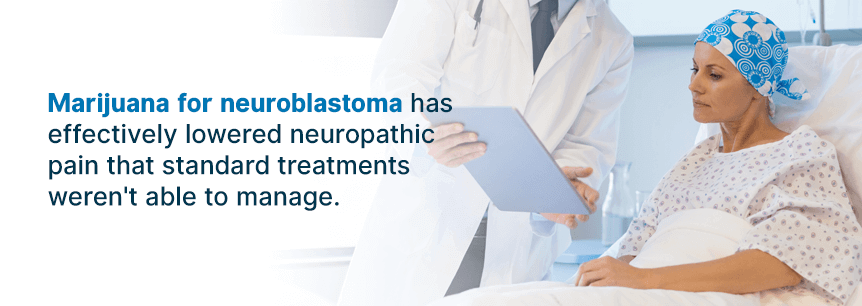
Researchers agree neuropathic pain is a complex condition, and finding safe and effective treatment options for people suffering is challenging. Medical weed could offer children with this type of pain an effective, safe and simple way of finding pain relief.
Strains for neuropathic pain may include:
For children with appetite loss and subsequent weight loss, cannabis stimulates the appetite. Marijuana and neuroblastoma treatment can stimulate metabolism, thereby increasing your child’s appetite. It’s likely you’ve heard the expression “having the munchies,” which refers to food cravings after using weed which can encourage your child to eat.
Strains to try for appetite loss include:
Though many people who use marijuana don’t experience any adverse side effects, some might react in unique ways.
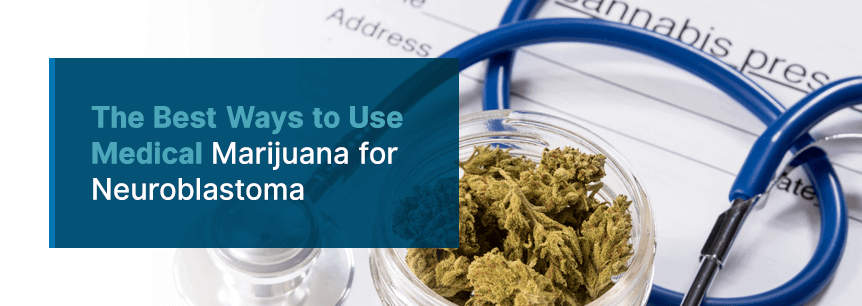
While smoking and vaping are the most popular methods of consumption, doctors may refrain from recommending them for children. Consider other methods that may help.
We understand a neuroblastoma diagnosis for your child is scary. But we also know the marijuana plant is highly useful in treating a whole range of negative health conditions. While some treatment options, like prescription medications, can cause debilitating side effects, negatively impacting the patient’s quality of life, medical cannabis is a beneficial option involving limited to no adverse effects or complications.
The medical marijuana experts at MarijuanaDoctors.com are ready to assist you in beginning a medical marijuana and neuroblastoma treatment. It’s a natural and affordable alternative or complementary medicine to other treatment options, having the potential to help treat and manage your child’s symptoms so they can live more comfortably.
Book your appointment today to speak with one of our qualified cannabis doctors in your area and find a marijuana dispensary so your child can start living a better quality of life.
Find A Doctor Find A Dispensary


Please allow us to access your location to find local dispensaries.
VIEW ALL DISPENSARIES ➔